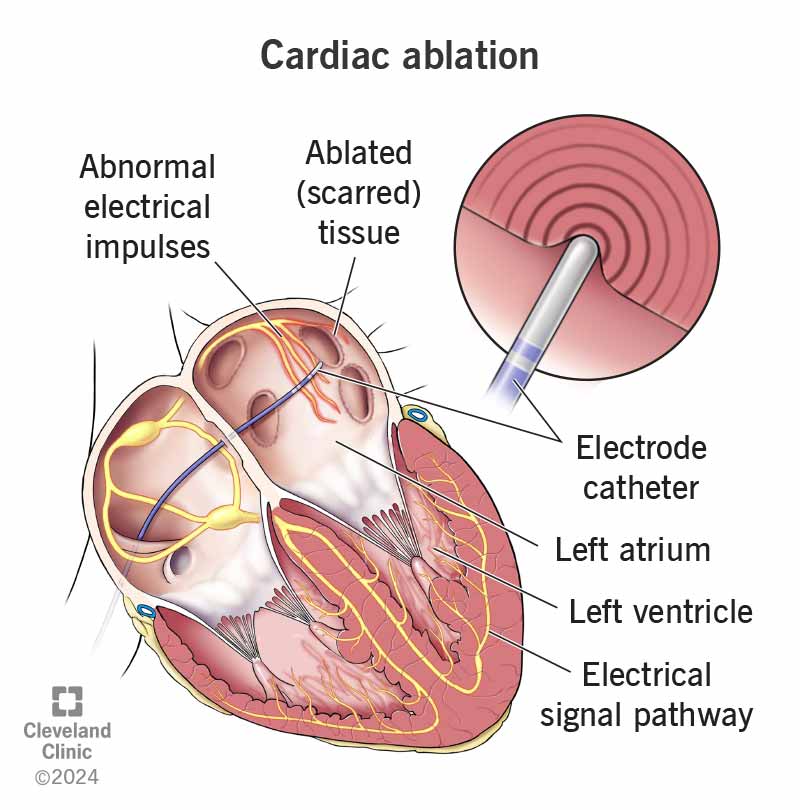Cardiac ablation (catheter ablation) is a minimally invasive procedure that creates scars to stop the electrical impulses that cause irregular heart rhythms. Healthcare providers can use cardiac ablation to manage abnormal heart rhythms that don’t respond to medication. They move catheters (tubes) through blood vessels to reach your heart.
Advertisement
Cleveland Clinic is a non-profit academic medical center. Advertising on our site helps support our mission. We do not endorse non-Cleveland Clinic products or services. Policy

Cardiac ablation (or catheter ablation) is a minimally invasive treatment for abnormal heart rhythms (arrhythmias). Healthcare providers use this procedure to find and treat abnormal tissue in your heart. This can correct your heart rhythm.
Advertisement
Cleveland Clinic is a non-profit academic medical center. Advertising on our site helps support our mission. We do not endorse non-Cleveland Clinic products or services. Policy
A cardiologist (heart specialist) performs a cardiac ablation procedure by inserting a catheter (tube) through a blood vessel to your heart. They use heat (radiofrequency ablation), cold (cryoablation) or short bursts of energy (pulsed field) to create scars in areas where the arrhythmia starts. These scars help block abnormal electrical impulses and prevent abnormal rhythms.
During heart ablation, you’ll generally receive sedation or possibly general anesthesia. The scars are meant to only affect tissue involved with faulty heart rhythms. They don’t cause any residual pain in your heart or create problems with your heart’s function.
Cardiac ablation treats most types of fast heart arrhythmias, but it’s not usually the first treatment providers try. Your cardiologist may suggest this procedure if you have an abnormal heart rhythm that medication can’t treat. Your provider will evaluate your heart and overall health to choose the best procedure to treat the arrhythmia that affects you.
A heart ablation procedure can treat these types of arrhythmias:
Advertisement
Healthcare providers may also recommend a cardiac ablation procedure if you’re at high risk of:
Before a cardiac ablation procedure, you may need to:
A provider will:
A cardiac ablation can take two to four hours to complete, but often longer. The exact length of time it takes is different from person to person.
After a cardiac ablation procedure, you move to a recovery room and stay there for several hours. A nurse monitors your condition while you recover. You’ll need to stay at the hospital for six to eight hours after the procedure. Depending on your condition, you may go home that day or spend the night at the hospital.
When it’s time to go home, you’ll receive detailed instructions about at-home care. Your provider may prescribe aspirin or other blood-thinning medication to help prevent blood clots. You may take this medicine for several months or longer after the procedure, depending on your medical history.
Cardiac ablation is a minimally invasive procedure that usually doesn’t require a prolonged hospital stay. A cardiac ablation procedure can restore a normal heart rhythm when medications fail. This procedure can even be lifesaving in some cases.
The cardiac ablation success rate varies by the type of abnormal heart rhythm you have. People with SVT may see a 90% to 95% success rate. But the success rate is only 60% to 80% for:
Advertisement
Cardiac ablation risks are low. People rarely have complications, especially at hospitals that perform a lot of cardiac ablations. Possible risks include:
You do receive some radiation during radiofrequency catheter ablation. If you’re pregnant, ask your provider if you can safely wait to have the procedure after delivering your baby.
Depending on the type of abnormal heart rhythm you have, a cardiac ablation may not work. And when the procedure works, the effect isn’t always immediate. You may have symptoms for several weeks before they improve, or you may need another ablation procedure in the future.
It can take several weeks to heal completely. During cardiac ablation recovery, you may continue to have arrhythmias while your heart tissue heals. This is normal.
You’ll likely have follow-up visits with your provider for a year after your cardiac ablation. If your symptoms come back during that time, you may need to repeat the procedure.
Unless your job involves heavy lifting or other physical labor, you’ll likely feel ready to return to work five to seven days after your catheter ablation procedure.
Advertisement
You should avoid heavy lifting (more than 10 pounds) and strenuous exercise for at least a week. Consult with your provider about when it’s safe to return to physical activity or driving.
You should call your healthcare provider if you experience:
Contact your provider if you have any questions or concerns about anything you’re feeling after a heart ablation.
No, a cardiac ablation isn’t major surgery. Providers perform this procedure through your blood vessels. They don’t open your chest. The only incision you’ll have is the one where they puncture your skin to go through your blood vessel.
Generally, cardiac ablation gives people mild discomfort for a short time. Many people have little or no discomfort from the ablation at all. Afterward, the site where the catheter went into your vein may be sore and have a bruise. The puncture is very small and should heal quickly.
Advertisement
The thought of a procedure on your heart can make you anxious. But a cardiac ablation generally has a low level of risk and helps many people with heart rhythm issues. It’s natural to have questions about a cardiac ablation, so don’t be afraid to ask. Understanding what the procedure involves can help put your mind at ease.
When your heart rhythm is out of sync, the experts at Cleveland Clinic can find out why. We offer personalized care for all types of arrhythmias.

Last reviewed on 11/07/2024.
Learn more about the Health Library and our editorial process.